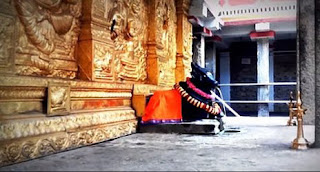Sri Dakshinamukha Nandi Tirtha Kalyani Kshetra is a small hindu temple located in Malleswaram, of Bengaluru city. Malleswaram, renowned for its ancient temples, is a centuries-old residential city. Malleswaram is an excellently-planned area located in the north-west of Bangalore. The name derives from the famous Temple of Kaadu Malleswara. This place is perfect for your next holiday trip.
 |
| Continuous water flows out of the Nandi's mouth |
Temple Name
Sri Dakshinamukha Nandi is one of the most mysterious temple in Bangalore, that was underground until. 1997, had a great surprise when finally unearthed. This ancient temple beside its mysteries has several names too. It is better known as the Nandishwara Tirtha. Malleswaram Nandi Gudi, Nandi Tirtha, Sri Dakshinamukha, Nandi Tirtha Kalyana Kshetra’, and others. This temple, is dedicated to Lord Shiva, it is open for worship, and for visiting and looking at its good condition, even though no one is sure exactly when it was built. There are also statues of Navagraha, or the Nine Planets and Lord Ganesh, inside its premises. Let's understand the meaning of the name, Sri Dakshinamukha Nandi Tirtha Kalyani Kshetra, Dakshinamukha means south facing (both the Shiva lingam and Nandi are placed facing the south pole), Nandi is the divine bull vahana (“mount”) of lord Shiva, Tirtha means sacred place of god or pilgrimage, Kalyani is the name of divine central stepped temple water tank, Kshetra means place.
Temple History
The ASI, states this temple is 400 years old, according to carbon dating studies. Others say the temple is much older, built 7000 years ago, although there is no strong evidence without the faded reference of the Puran. But detailed study of the entire history of every ancient temple shows that restoring or adding new sections to the main shrine was customary in every corner of civilizations. This is why almost all the ancient temples have several styles of artifacts of more than one period. We know the Somnath temple was built many times on the same ancient structural platform. The first construction of Dakshinamukha Nandi temple may have started 7000 years ago and maximum sections of this temple may have been renovated only 400 years ago. Which portion was examined by the ASI.
Excavation
Situated in the center of Malleswaram town, this sacred shrine is a stunning, peaceful destination.The temple went underground in the course of time. Since this temple is below the surrounding area 's general ground level; and because there was no Gopram tower (the entrance tower), the entire temple was vanished from view. However, some old people living in the area heard about the existence of this temple from their ancestors. As land prices continued to rise in Malleswaram, Bangalore, a project was launched, in 1997, to sell all the vacant plots in the city, converting them habitable.
But since people of this local area knew about the possibility of existing a temple under the plot, they interrupted the project activities on this temple land. The land in question was dug up after protests by the city community and the temple complex slowly appeared from under the ground and gravel.
Temple Architecture
Surprisingly the temple is in good condition, with strong pillars supporting a well preserved stone courtyard. In almost all Hindu temples, it is customary to place Nandi in front of or near the Shivling. But here in this temple, the Nandi is placed on a platform installed above the Shivalinga. A continual stream of water flows out of the mouth of the Nandi and falls through a hole in the floor onto the Shivaling. The water then gathers in the medium sized reservoir and the extra water is drained outside the temple into the open well.
 |
| The continuous water falls on Shiva Lingam |
Ancient Hydraulic Engineering
A statue of Nandi, carved out of black stone, is well preserved. There is a Shivalinga below Nandi, the miracle is that a stream of water comes out of Nandi's mouth, and bathes the Shivalinga below the amazing fact is that no one is sure about the real source of the continuous stream of water that comes out of Nandi on the Shivalinga. Some suspect there could be natural freshwater springs, under the shrine, that are channelized to flow out of the Nandi mouth. Other say it comes from the Sankey Tank, but this tank was built in 1882, the Nandi statue and Shivalinga, were built several years earlier. Also the Nandi's water is collected in a deep stepped tank called Kalyani, or pool, with a depth of 15ft and a whirlpool. There are turtles and fish can be seen. Which is undoubtedly a pleasant scene for the visitor or devotees.
This water from Nandi's mouth and this tank are amazing ancient hydraulic engineering. After all these years, the temple is in good condition, only needs small maintenance. During festival, like Shivaratri, many devotees attend. Something unusual is the orientation of the statues, facing south, and reason why this temple is also called Dakhinamukha Temple. This temple has been for many years a hidden jewel with the mystery of the water stream that comes out of Nandi and continuous bathes the Shivaling, with cool and blessed water. Despite hydraulic engineering, the architects of the sanctuary and their age are the secrets to be explored too. The temple has been buried for centuries and yet it has not lost any of its charm and elegance, which in itself is one of the magnificent reality of the temple. However most astonishing fact about the temple is, no one has identified the source of the fresh water flow and mechanism behind the continuous flow to remain elusive till now.
Temple Visiting Hours
The temple is open from 7:30 a.m. to 12:00 p.m., and from 5:00 p.m. to 8:30 p.m for offering puja.
No comments:
Post a Comment
Please do not enter any spam link in the comment box. Thanks for reading our articles.